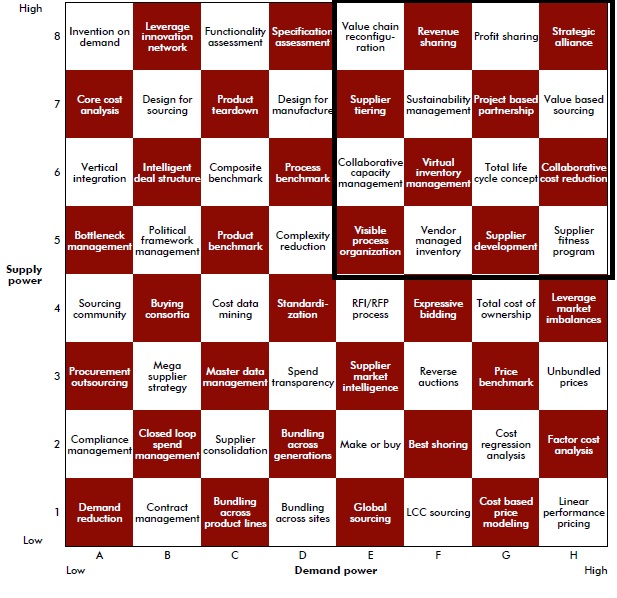We finalize the consideration of the different sourcing strategies which are based on features of supply and demand power according to A.T.Kearney approaches in this article. And today we will analyze the fourth strategy. Where there is both high supply power and high demand power, the basic strategy aims at searching jointly with the supplier for advantages. The different variants of this basic strategy depend on the scope and intensity of the partnership. The scope can range from coordinated demand and capacity planning to complete intermeshing of the value chain. Meanwhile, the intensity can range from project based sharing of costs to the sharing of financial success and risk.
The approaches for cutting costs and increasing value within this basic
strategy are integrated operations planning, value chain management,
cost partnership, and value partnership.
These approaches and their underlying methods are briefly shown of the picture below.
 Picture 1. The approaches for cutting costs and increasing value in case of high supply power and high demand power
Picture 1. The approaches for cutting costs and increasing value in case of high supply power and high demand power
Integrated operations planning
Rather than achieving direct reductions in a component price, integrated operations planning tries to achieve targeted savings by decreasing inventories and making sales forecasts more reliable which in turn improves the capacity and demand balance. The supplier and customer collaborate in a spirit of trust and exchange information with one another, often supported by internet applications. This is a true partnership on the operating level, but one that calls for great openness in terms of exchanging information.
It is an important approach not only for cutting costs but also for adding value, since it avoids component/capacity bottlenecks, thus increasing sales revenues. Integrated operations planning encompasses the following methods:E5. Visible process organization: This is an innovative form of organization characterized by the permanent co-location of decision makers and the implementation of a dynamic re-planning process. Through improved information flows, the company avoids disruption costs.
E6. Collaborative capacity management: Deficient communication between customer and supplier can lead to capacity bottlenecks and production losses, with sometimes serious consequences. Collaborative capacity management ensures ongoing reconciliation between demand and capacity with regard to a selected critical component volume.
F5. Vendor managed inventory: Here, inventory management is placed entirely in the hands of the supplier. The supplier usually has electronic access to consumption and inventory data. Greater planning freedom enables the supplier to cut costs.
F6. Virtual inventory management: All inventories at the supplier and customer locations, as well as in the hands of logistics partners (i.e. en route), are included in the inventory optimization process. If IT inventory systems do not supply integrated data, an auxiliary solution will be necessary.
Value chain management
The focus of this approach is on systematically optimizing the value chain and the associated value-generating units. Trustworthy handling of company data (sales revenue, value stages, suppliers’ buying costs, etc.) is a fundamental requirement for the successful implementation of improvements through value chain management. Value chain management encompasses the following methods:
E7. Supplier tiering: Supplier tiering can work in two directions: it uses key suppliers to bundle upstream tier-2 suppliers, thus relieves the company of the need to manage a large number of suppliers; or it does the exact opposite by breaking up already existing structures and cutting out tier-1 supplier.
E8. Value chain reconfiguration: Existing value chains are analyzed, broken down into their component parts, and then recombined in a new configuration. The aim is to acquire or maintain maximum control of key stages and processes, thus internalizing core competencies as a competitive advantage.
F7. Sustainability management: Sustainability management is the integrated management of the company and its value-creation chain in accordance with economic, social, and ecological principles. For example, environmental measures may enable the company to save costs or prevent damage to its image.
F8. Revenue sharing: A defined percentage of sales revenue is shared with the supplier. This makes sense especially in cases
where a bought-in part contributes significantly to the overall perception of a product.Cost partnership
Here the goal is to optimize costs through collaboration on a partnership basis. Crucial for the success of this approach is a focus on a small number of suppliers and on achieving genuinely significant savings. A cost partnership encompasses the following methods:
G5. Supplier development: Supplier development has the aim of fostering attractive new suppliers and/or small incumbent ones, and developing them into key suppliers.
G6. Total lifecycle concept: The total lifecycle concept regulates in detail how sales revenue and costs are distributed between the company and suppliers over the entire product lifecycle.
H5. Supplier fitness program: The supplier fitness program helps suppliers through targeted measures to eliminate weaknesses within their own value creation processes, thus making them more competitive.
H6. Collaborative cost reduction: The company and suppliers jointly develop ideas for cutting costs and then share the savings.
Value partnership
The goal of a value partnership is to optimize value growth and to share the business risk. Crucial for the success of this approach is the creation of a genuine win-win situation. A value partnership encompasses the following methods:
G7. Project based partnership: For companies and suppliers wanting to cooperate for a limited period and within a limited scope, a project based partnership is a suitable cooperation model.
G8. Profit sharing: Instead of the traditional method of paying suppliers a product-based purchasing price, one can agree to share the profit. This especially makes sense when the supplier has an overwhelming influence on the success of the business.
H7. Value based sourcing: Value based sourcing is an approach whereby suppliers are selected in terms of their capabilities and are continually encouraged to innovate, the goal being value maximization.
H8. Strategic alliance: Strategic alliances with suppliers, i.e. permanent collaboration with a partner, are appropriate where a company does not wish or is not able to maintain certain strategic capabilities internally, or has no possibility of vertical integration.

